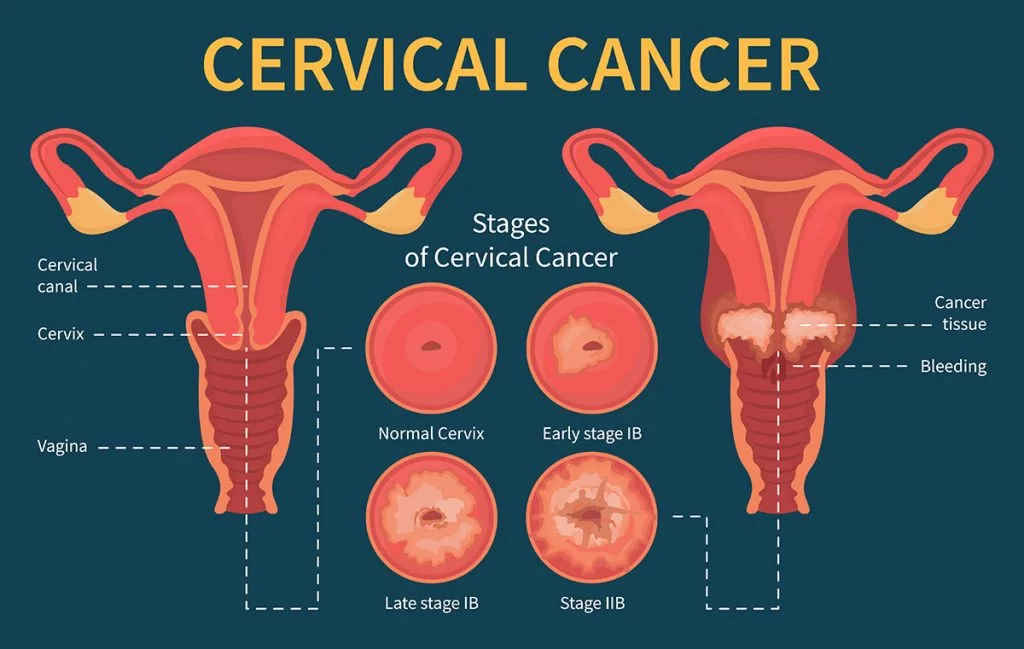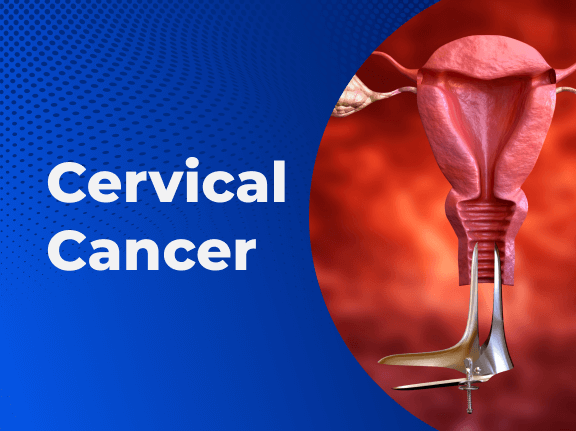Cervical cancer is the second most common cancer type for women with 12.8% of women being diagnosed throughout their life. Even though most people think of women when it comes to cervical cancer, roughly 1% of patients are male.
Cervical cancer may be detected during screenings or once the patient shows various symptoms, which usually appear in the advanced stages. The largest risk factor of developing cervical cancer is Human Papilloma Virus (HPV).
9 out of 10 cases of cervical cancer are squamous. It develops from squamous cells in the part of the cervix closest to the vagina. Another type of cervical cancer is adenocarcinoma, which develops in the glandular cells of the part closest to the uterus.
Cervical Cancer Symptoms
Early-stage cervical cancer usually does not show any symptoms. Symptoms that occur in the late stages can be confused with pain during menstrual periods and urinary tract infections. The most common late-stage symptoms include:
- Pain in the pelvis
- Unusual bleeding that occurs despite menopause
- Vaginal discharge with an unusual appearance or smell
- Longer than usual and heavier menstrual bleeding
- Need to urinate more often and urinary incontinence
- Burning and pain when urinating
- Bleeding and pain that occur outside of menstrual days
- Bleeding after intercourse, shower or pelvic exam
- Unexplained and persistent back pain
- Intense pain during sexual intercourse
Although some of these symptoms seem like the symptoms of other non-cancer diseases, it is important to take symptoms seriously and consult a specialist for early diagnosis. The sooner precancerous cells or cancer are detected and treated, the more likely the cancer will be prevented and cured.
Cervical Cancer Diagnosis
The Pap Smear Test is used for the diagnosis of cervical cancer. This test is recommended from the age of 21 or 3 years after the first time experiencing sexual intercourse. Women are recommended to have a Pap Smear Test once a year to prevent cancer.

Approximately 15 days must have passed since the beginning of the last menstrual period for the test to be successful. In addition, sexual intercourse should be avoided 2 days before the test. It is important to clean the vagina carefully. If there is a vaginal infection, testing should not be done before treatment for this infection.
One of the most important methods of early detection of any female disease is the regular gynecological examination. Since the clinical manifestations of precancerous and underlying diseases are not pronounced, differential diagnosis of cervical cancer will help to detect changes, including:
- Colposcopy
- Targeted cervical biopsy
- Cytological screening
- Visual examination of the genitals
- Bacteriological examination
- Endocervical curettage (endocervical scraping)
- Biopsy of tissue from suspicious areas of the cervix
- Screening for sexually transmitted infections
When monitoring the epithelium of the cervix, diagnostic methods are also used, such as:
- PET/CT
- Ultrasound
- Optical coherence tomography
- Use of tumor marker SCC (squamous cell carcinoma)
- Fluorescence spectroscopy
- Lung radiography
- MRI
- Urography
- Cystoscopy
- CT scan
Cervical Cancer Risk Factors
HPV infection is the most common symptom among Cervical cancer risk factors. Approximately 95% of the patients are HPV DNA positive, which is primarily contracted through sexual intercourse or other skin on skin contact in the genital region. Cervical cancer develops slowly over a few years. It causes abnormal vaginal bleeding or discharge in some women, while some women do not show any symptoms until later stages.
Other risk factors include:
- Smoking
- Giving birth to multiple children
- Using the oral form of contraceptives over a long period of time
- Many sexual partners
- Not practicing safe sex
Cervical Cancer Stages
Determining the stage of the disease in each type of cancer is a general procedure followed to decide treatment methods. In this sense, cervical cancer is classified in 4 main stages:
Stage I: Cancer is in the cervix and has not spread.
- 1a) Microscopic cancer limited to the cervix, visible only by biopsy
- 1b) Cancer can be seen with the naked eye during the examination
- b1) Cancer smaller than 4 cm
- b2) Cancer larger than 4 cm
Stage II: Cancer has started to spread beyond the cervix. Soft Tissue Sarcoma near the cervix, cancer that has spread to the vaginal dome (vaginal cuff).
Stage III (locally advanced): The cancer has spread beyond the cervix and the following signs / symptoms have started to appear:
- Mass sensation in the vaginal region
- The enlarged lymph nodes may cause leg swelling
- Blockage to the urine tract
Stage IV (advanced or metastatic): The cancer has spread beyond the cervix or any of the above-mentioned areas and has spread to distant organs such as a bladder, rectum, bones, liver or lung.
Cervical Cancer Treatment
Cervical cancer is a disease that usually spreads locally. It usually metastasizes through the lymph tract. Organ metastasis through the blood vessel is much less common. Treatment depends on many factors, including the stage of the malignant neoplasm. Common treatments are surgery:
- Chemotherapy and radiotherapy
- Immunotherapy applied simultaneously with other treatments
- Surgical removal of the tumor area
If the above treatments are not effective, clinical trials may be a good option for these patients. Patients at any stage of the disease can be included in clinical trials, if they meet the enrollment criteria. Clinical research with the development of new drugs, targeted therapies and immunotherapies may offer hope for advanced cervical cancer patients. If you want to be a part of a clinical trial and search for promising clinical trials near you, you can contact Massive Bio. Thousands of clinical trials are available for cancer patients and our artificial intelligence powered platform finds matching trials for you.
Various specialists can be involved in them, including:
Gynecologist-oncologist a doctor who specializes in the treatment of cancer of the female genital organs, including surgery to remove it.
Radiation oncologist a doctor who uses radiation to treat various types of cancer.
Medical oncologist a specialist in the use of chemotherapy and other medical methods of treatment.
Early diagnosis, vaccines to prevent HPV infection, screening tests, and treatment for cervical cancer in women are critical to reducing mortality. If the neoplasm is detected in the zero and the first stage, then the percentage of recovery ranges from 80 to 100%.
Five-year survival by stage of cervical cancer:
- I – 80-93%
- II – 58-63%
- III – 32-35%
- IV – 15-16%
Cervical Cancer Clinical Trials
Clinical trials for cancer patients offer access to new studies that are not widely available. Massive Bio guides patients through the most comprehensive clinical trial matching process. Participating in a clinical trial provides access to new studies that are not yet widely available.
Studies are ongoing to offer treatment methods for advanced or recurrent cervical cancer patients to identify vaccines that target other HPV-types associated with cervical cancer in order to help the immune system destroy HPV for infected patients. If you want to learn more about these treatments, you can consult the team at Massive Bio.












